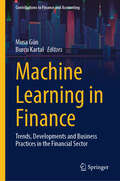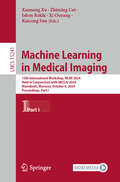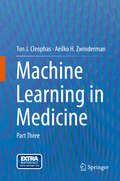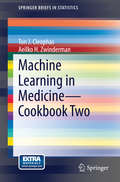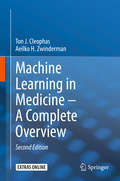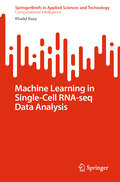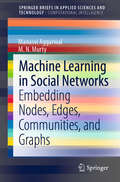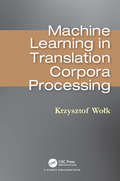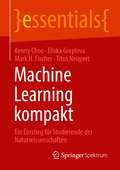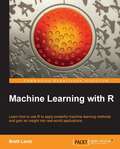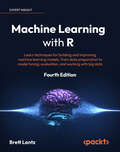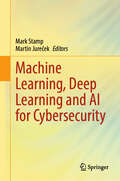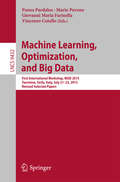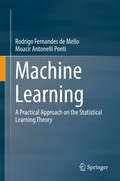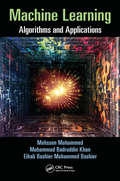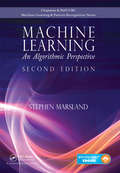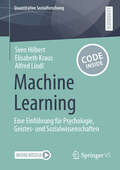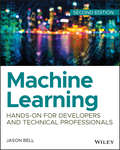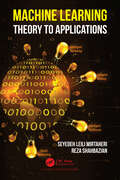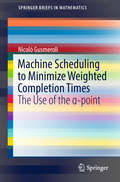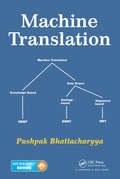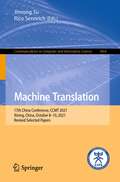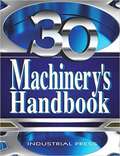- Table View
- List View
Machine Learning in Finance: Trends, Developments and Business Practices in the Financial Sector (Contributions to Finance and Accounting)
by Musa Gün Burcu KartalThis book discusses the evolution of technical features in decentralized finance and focuses on machine-learning finance in emerging economies. As technological advancement evolves at an unpredictable pace, the financial industry, like every other sector, must adapt accordingly. Furthermore, the rapid expansion of diverse financial products and services is creating new applications and markets. Alongside technological progress, the exploration of complex patterns in vast amounts of data, known as big data, is facilitated by its commonly acknowledged characteristics: volume, variety, veracity, value, and velocity. Overall, machine learning has become crucial in the financial industry, allowing businesses to automate operations, gain insights from data, and make more informed decisions in real time. This edited book covers algorithmic trading, risk management, fraud detection, customer service and personalization, portfolio management, credit scoring, sentiment analysis, and algorithmic pricing. The book connects theoretical concepts with practical real-world applications, benefiting professionals looking to enhance their proficiency in using these methods efficiently. It offers insightful guidance for theorists, market participants, and policymakers by exploring financial theories and practices in light of contemporary machine-learning approaches, with a special emphasis on emerging economies.
Machine Learning in Medical Imaging: 15th International Workshop, MLMI 2024, Held in Conjunction with MICCAI 2024, Marrakesh, Morocco, October 6, 2024, Proceedings, Part I (Lecture Notes in Computer Science #15241)
by Islem Rekik Xuanang Xu Zhiming Cui Xi Ouyang Kaicong SunThis book constitutes the proceedings of the 15th International Workshop on Machine Learning in Medical Imaging, MLMI 2023, held in conjunction with MICCAI 2024, Marrakesh, Morocco, on October 6, 2024. The 63 full papers presented in this volume were carefully reviewed and selected from 100 submissions. They focus on major trends and challenges in the above-mentioned area, aiming to identify new-cutting-edge techniques and their uses in medical imaging using artificial intelligence (AI) and machine learning (ML).
Machine Learning in Medical Imaging: 15th International Workshop, MLMI 2024, Held in Conjunction with MICCAI 2024, Marrakesh, Morocco, October 6, 2024, Proceedings, Part II (Lecture Notes in Computer Science #15242)
by Islem Rekik Xuanang Xu Zhiming Cui Xi Ouyang Kaicong SunThis book constitutes the proceedings of the 15th International Workshop on Machine Learning in Medical Imaging, MLMI 2024, held in conjunction with MICCAI 2024, Marrakesh, Morocco, on October 6, 2024. The 63 full papers presented in this volume were carefully reviewed and selected from 100 submissions. They focus on major trends and challenges in the above-mentioned area, aiming to identify new-cutting-edge techniques and their uses in medical imaging using artificial intelligence (AI) and machine learning (ML).
Machine Learning in Medicine
by Aeilko H. Zwinderman Ton J. CleophasMachine learning is a novel discipline concerned with the analysis of large and multiple variables data. It involves computationally intensive methods, like factor analysis, cluster analysis, and discriminant analysis. It is currently mainly the domain of computer scientists, and is already commonly used in social sciences, marketing research, operational research and applied sciences. It is virtually unused in clinical research. This is probably due to the traditional belief of clinicians in clinical trials where multiple variables are equally balanced by the randomization process and are not further taken into account. In contrast, modern computer data files often involve hundreds of variables like genes and other laboratory values, and computationally intensive methods are required. This book was written as a hand-hold presentation accessible to clinicians, and as a must-read publication for those new to the methods.
Machine Learning in Medicine - Cookbook Two
by Aeilko H. Zwinderman Ton J. CleophasThe amount of data medical databases doubles every 20 months, and physicians are at a loss to analyze them. Also, traditional data analysis has difficulty to identify outliers and patterns in big data and data with multiple exposure / outcome variables and analysis-rules for surveys and questionnaires, currently common methods of data collection, are, essentially, missing. Consequently, proper data-based health decisions will soon be impossible. Obviously, it is time that medical and health professionals mastered their reluctance to use machine learning methods and this was the main incentive for the authors to complete a series of three textbooks entitled "Machine Learning in Medicine Part One, Two and Three, Springer Heidelberg Germany, 2012-2013", describing in a nonmathematical way over sixty machine learning methodologies, as available in SPSS statistical software and other major software programs. Although well received, it came to our attention that physicians and students often lacked time to read the entire books, and requested a small book, without background information and theoretical discussions and highlighting technical details. For this reason we produced a 100 page cookbook, entitled "Machine Learning in Medicine - Cookbook One", with data examples available at extras. springer. com for self-assessment and with reference to the above textbooks for background information. Already at the completion of this cookbook we came to realize, that many essential methods were not covered. The current volume, entitled "Machine Learning in Medicine - Cookbook Two" is complementary to the first and also intended for providing a more balanced view of the field and thus, as a must-read not only for physicians and students, but also for any one involved in the process and progress of health and health care. Similarly to Machine Learning in Medicine - Cookbook One, the current work will describe stepwise analyses of over twenty machine learning methods, that are, likewise, based on the three major machine learning methodologies: Cluster methodologies (Chaps. 1-3) Linear methodologies (Chaps. 4-11) Rules methodologies (Chaps. 12-20) In extras. springer. com the data files of the examples are given, as well as XML (Extended Mark up Language), SPS (Syntax) and ZIP (compressed) files for outcome predictions in future patients. In addition to condensed versions of the methods, fully described in the above three textbooks, an introduction is given to SPSS Modeler (SPSS' data mining workbench) in the Chaps. 15, 18, 19, while improved statistical methods like various automated analyses and Monte Carlo simulation models are in the Chaps. 1, 5, 7 and 8. We should emphasize that all of the methods described have been successfully applied in practice by the authors, both of them professors in applied statistics and machine learning at the European Community College of Pharmaceutical Medicine in Lyon France. We recommend the current work not only as a training companion to investigators and students, because of plenty of step by step analyses given, but also as a brief introductory text to jaded clinicians new to the methods. For the latter purpose, background and theoretical information have been replaced with the appropriate references to the above textbooks, while single sections addressing "general purposes", "main scientific questions" and "conclusions" are given in place. Finally, we will demonstrate that modern machine learning performs sometimes better than traditional statistics does. Machine learning may have little options for adjusting confounding and interaction, but you can add propensity scores and interaction variables to almost any machine learning method.
Machine Learning in Medicine – A Complete Overview
by Aeilko H. Zwinderman Ton J. CleophasAdequate health and health care is no longer possible without proper data supervision from modern machine learning methodologies like cluster models, neural networks, and other data mining methodologies. The current book is the first publication of a complete overview of machine learning methodologies for the medical and health sector, and it was written as a training companion, and as a must-read, not only for physicians and students, but also for any one involved in the process and progress of health and health care.In this second edition the authors have removed the textual errors from the first edition. Also, the improved tables from the first edition, have been replaced with the original tables from the software programs as applied. This is, because, unlike the former, the latter were without error, and readers were better familiar with them.The main purpose of the first edition was, to provide stepwise analyses of the novel methods from data examples, but background information and clinical relevance information may have been somewhat lacking. Therefore, each chapter now contains a section entitled "Background Information".Machine learning may be more informative, and may provide better sensitivity of testing than traditional analytic methods may do. In the second edition a place has been given for the use of machine learning not only to the analysis of observational clinical data, but also to that of controlled clinical trials.Unlike the first edition, the second edition has drawings in full color providing a helpful extra dimension to the data analysis.Several machine learning methodologies not yet covered in the first edition, but increasingly important today, have been included in this updated edition, for example, negative binomial and Poisson regressions, sparse canonical analysis, Firth's bias adjusted logistic analysis, omics research, eigenvalues and eigenvectors.
Machine Learning in Single-Cell RNA-seq Data Analysis (SpringerBriefs in Applied Sciences and Technology)
by Khalid RazaThis book provides a concise guide tailored for researchers, bioinformaticians, and enthusiasts eager to unravel the mysteries hidden within single-cell RNA sequencing (scRNA-seq) data using cutting-edge machine learning techniques. The advent of scRNA-seq technology has revolutionized our understanding of cellular diversity and function, offering unprecedented insights into the intricate tapestry of gene expression at the single-cell level. However, the deluge of data generated by these experiments presents a formidable challenge, demanding advanced analytical tools, methodologies, and skills for meaningful interpretation. This book bridges the gap between traditional bioinformatics and the evolving landscape of machine learning. Authored by seasoned experts at the intersection of genomics and artificial intelligence, this book serves as a roadmap for leveraging machine learning algorithms to extract meaningful patterns and uncover hidden biological insights within scRNA-seq datasets.
Machine Learning in Social Networks: Embedding Nodes, Edges, Communities, and Graphs (SpringerBriefs in Applied Sciences and Technology)
by M.N. Murty Manasvi AggarwalThis book deals with network representation learning. It deals with embedding nodes, edges, subgraphs and graphs. There is a growing interest in understanding complex systems in different domains including health, education, agriculture and transportation. Such complex systems are analyzed by modeling, using networks that are aptly called complex networks. Networks are becoming ubiquitous as they can represent many real-world relational data, for instance, information networks, molecular structures, telecommunication networks and protein–protein interaction networks. Analysis of these networks provides advantages in many fields such as recommendation (recommending friends in a social network), biological field (deducing connections between proteins for treating new diseases) and community detection (grouping users of a social network according to their interests) by leveraging the latent information of networks. An active and important area of current interest is to come out with algorithms that learn features by embedding nodes or (sub)graphs into a vector space. These tasks come under the broad umbrella of representation learning. A representation learning model learns a mapping function that transforms the graphs' structure information to a low-/high-dimension vector space maintaining all the relevant properties.
Machine Learning in Translation Corpora Processing
by Krzysztof WolkThis book reviews ways to improve statistical machine speech translation between Polish and English. Research has been conducted mostly on dictionary-based, rule-based, and syntax-based, machine translation techniques. Most popular methodologies and tools are not well-suited for the Polish language and therefore require adaptation, and language resources are lacking in parallel and monolingual data. The main objective of this volume to develop an automatic and robust Polish-to-English translation system to meet specific translation requirements and to develop bilingual textual resources by mining comparable corpora.
Machine Learning kompakt: Ein Einstieg für Studierende der Naturwissenschaften (essentials)
by Kenny Choo Eliska Greplova Mark H. Fischer Titus NeupertDieses essential befasst sich mit Anwendungen des maschinellen Lernens in verschiedenen Bereichen der Naturwissenschaften. Es behandelt geläufige Strukturen und Algorithmen, um Daten mit den Techniken des maschinellen Lernens zu analysieren. Zunächst werden Methoden eingeführt, die an klassischen statistischen Analysen andocken und auf soliderem mathematischem Fundament stehen. Die Autoren machen mit den verschiedenen Strukturen für künstliche neuronale Netzwerke vertraut und zeigen die jeweiligen Anwendungsgebiete.
Machine Learning with R
by Brett LantzWritten as a tutorial to explore and understand the power of R for machine learning. This practical guide that covers all of the need to know topics in a very systematic way. For each machine learning approach, each step in the process is detailed, from preparing the data for analysis to evaluating the results. These steps will build the knowledge you need to apply them to your own data science tasks.Intended for those who want to learn how to use R's machine learning capabilities and gain insight from your data. Perhaps you already know a bit about machine learning, but have never used R; or perhaps you know a little R but are new to machine learning. In either case, this book will get you up and running quickly. It would be helpful to have a bit of familiarity with basic programming concepts, but no prior experience is required.
Machine Learning with R Cookbook
by Yu-Wei ChiuIf you want to learn how to use R for machine learning and gain insights from your data, then this book is ideal for you. Regardless of your level of experience, this book covers the basics of applying R to machine learning through to advanced techniques. While it is helpful if you are familiar with basic programming or machine learning concepts, you do not require prior experience to benefit from this book.
Machine Learning with R: Learn techniques for building and improving machine learning models, from data preparation to model tuning, evaluation, and working with big data, 4th Edition
by Brett LantzLearn how to solve real-world data problems using machine learning and RPurchase of the print or Kindle book includes a free eBook in PDF format.Key FeaturesThe 10th Anniversary Edition of the bestselling R machine learning book, updated with 50% new content for R 4.0.0 and beyondHarness the power of R to build flexible, effective, and transparent machine learning modelsLearn quickly with this clear, hands-on guide by machine learning expert Brett LantzBook DescriptionMachine learning, at its core, is concerned with transforming data into actionable knowledge. R offers a powerful set of machine learning methods to quickly and easily gain insight from your data. Machine Learning with R, Fourth Edition, provides a hands-on, accessible, and readable guide to applying machine learning to real-world problems. Whether you are an experienced R user or new to the language, Brett Lantz teaches you everything you need to know for data pre-processing, uncovering key insights, making new predictions, and visualizing your findings. This 10th Anniversary Edition features several new chapters that reflect the progress of machine learning in the last few years and help you build your data science skills and tackle more challenging problems, including making successful machine learning models and advanced data preparation, building better learners, and making use of big data.You'll also find this classic R data science book updated to R 4.0.0 with newer and better libraries, advice on ethical and bias issues in machine learning, and an introduction to deep learning. Whether you're looking to take your first steps with R for machine learning or making sure your skills and knowledge are up to date, this is an unmissable read that will help you find powerful new insights in your data.What you will learnLearn the end-to-end process of machine learning from raw data to implementationClassify important outcomes using nearest neighbor and Bayesian methodsPredict future events using decision trees, rules, and support vector machinesForecast numeric data and estimate financial values using regression methodsModel complex processes with artificial neural networksPrepare, transform, and clean data using the tidyverseEvaluate your models and improve their performanceConnect R to SQL databases and emerging big data technologies such as Spark, Hadoop, H2O, and TensorFlowWho this book is forThis book is designed to help data scientists, actuaries, data analysts, financial analysts, social scientists, business and machine learning students, and any other practitioners who want a clear, accessible guide to machine learning with R. No R experience is required, although prior exposure to statistics and programming is helpful.
Machine Learning, Deep Learning and AI for Cybersecurity
by Mark Stamp Martin JurečekThis book addresses a variety of problems that arise at the interface between AI techniques and challenging problems in cybersecurity. The book covers many of the issues that arise when applying AI and deep learning algorithms to inherently difficult problems in the security domain, such as malware detection and analysis, intrusion detection, spam detection, and various other subfields of cybersecurity. The book places particular attention on data driven approaches, where minimal expert domain knowledge is required. This book bridges some of the gaps that exist between deep learning/AI research and practical problems in cybersecurity. The proposed topics cover a wide range of deep learning and AI techniques, including novel frameworks and development tools enabling the audience to innovate with these cutting-edge research advancements in various security-related use cases. The book is timely since it is not common to find clearly elucidated research that applies the latest developments in AI to problems in cybersecurity.
Machine Learning, Optimization, and Big Data
by Panos Pardalos Vincenzo Cutello Mario Pavone Giovanni Maria FarinellaThis bookconstitutes revised selected papers from the First International Workshop onMachine Learning, Optimization, and Big Data, MOD 2015, held in Taormina, Sicily,Italy, in July 2015. The 32papers presented in this volume were carefully reviewed and selected from 73submissions. They deal with the algorithms, methods and theories relevant indata science, optimization and machine learning.
Machine Learning: A Practical Approach on the Statistical Learning Theory
by Rodrigo Fernandes de Mello Moacir Antonelli PontiThis book presents the Statistical Learning Theory in a detailed and easy to understand way, by using practical examples, algorithms and source codes. It can be used as a textbook in graduation or undergraduation courses, for self-learners, or as reference with respect to the main theoretical concepts of Machine Learning. Fundamental concepts of Linear Algebra and Optimization applied to Machine Learning are provided, as well as source codes in R, making the book as self-contained as possible.It starts with an introduction to Machine Learning concepts and algorithms such as the Perceptron, Multilayer Perceptron and the Distance-Weighted Nearest Neighbors with examples, in order to provide the necessary foundation so the reader is able to understand the Bias-Variance Dilemma, which is the central point of the Statistical Learning Theory.Afterwards, we introduce all assumptions and formalize the Statistical Learning Theory, allowing the practical study of different classification algorithms. Then, we proceed with concentration inequalities until arriving to the Generalization and the Large-Margin bounds, providing the main motivations for the Support Vector Machines. From that, we introduce all necessary optimization concepts related to the implementation of Support Vector Machines. To provide a next stage of development, the book finishes with a discussion on SVM kernels as a way and motivation to study data spaces and improve classification results.
Machine Learning: Algorithms and Applications
by Muhammad Khan Mohssen Mohammed Eihab BashierMachine learning, one of the top emerging sciences, has an extremely broad range of applications. However, many books on the subject provide only a theoretical approach, making it difficult for a newcomer to grasp the subject material. This book provides a more practical approach by explaining the concepts of machine learning algorithms and describing the areas of application for each algorithm, using simple practical examples to demonstrate each algorithm and showing how different issues related to these algorithms are applied.
Machine Learning: An Algorithmic Perspective, Second Edition
by Stephen MarslandA Proven, Hands-On Approach for Students without a Strong Statistical FoundationSince the best-selling first edition was published, there have been several prominent developments in the field of machine learning, including the increasing work on the statistical interpretations of machine learning algorithms. Unfortunately, computer science students
Machine Learning: Eine Einführung für Psychologie, Geistes- und Sozialwissenschaften (Quantitative Sozialforschung)
by Alfred Lindl Sven Hilbert Elisabeth KrausDieses Buch richtet sich an alle, welche die enormen Potenziale maschinellen Lernens für wissenschaftliche Fragestellungen und innovative Ansätze in Studium oder Beruf nutzen möchten. Denn maschinelles Lernen eröffnet neue Möglichkeiten zum effizienten Umgang mit umfassenden, komplex strukturierten und sich schnell entwickelnden Daten. Zunächst werden Grundideen und typische Anwendungsfelder maschinellen Lernens sowie dessen Vorzüge gegenüber inferenzstatistischen Verfahren erläutert. Daran schließen praktische Hinweise dazu an, wie Daten für maschinelle Lernprozesse aufbereitet werden und wie diese durch Anpassung verschiedener Parameter möglichst optimale Ergebnisse erzielen können. Von den hierzu einsetzbaren Modellen werden die gängigsten theoretisch und anhand anschaulicher Beispiele vorgestellt. Auch auf verschiedene Optionen zur besseren Interpretierbarkeit sowie auf spezifische Limitationen von Analyseresultaten wird eingegangen. Weiterführende Anwendungsfälle und verständlich kommentierte Analysecodes sind auf dem GitHub-Repositorium zu diesem Buch auf SpringerLink online verfügbar.
Machine Learning: Hands-On for Developers and Technical Professionals
by Jason BellDig deep into the data with a hands-on guide to machine learning with updated examples and more! Machine Learning: Hands-On for Developers and Technical Professionals provides hands-on instruction and fully-coded working examples for the most common machine learning techniques used by developers and technical professionals. The book contains a breakdown of each ML variant, explaining how it works and how it is used within certain industries, allowing readers to incorporate the presented techniques into their own work as they follow along. A core tenant of machine learning is a strong focus on data preparation, and a full exploration of the various types of learning algorithms illustrates how the proper tools can help any developer extract information and insights from existing data. The book includes a full complement of Instructor's Materials to facilitate use in the classroom, making this resource useful for students and as a professional reference. At its core, machine learning is a mathematical, algorithm-based technology that forms the basis of historical data mining and modern big data science. Scientific analysis of big data requires a working knowledge of machine learning, which forms predictions based on known properties learned from training data. Machine Learning is an accessible, comprehensive guide for the non-mathematician, providing clear guidance that allows readers to: Learn the languages of machine learning including Hadoop, Mahout, and Weka Understand decision trees, Bayesian networks, and artificial neural networks Implement Association Rule, Real Time, and Batch learning Develop a strategic plan for safe, effective, and efficient machine learning By learning to construct a system that can learn from data, readers can increase their utility across industries. Machine learning sits at the core of deep dive data analysis and visualization, which is increasingly in demand as companies discover the goldmine hiding in their existing data. For the tech professional involved in data science, Machine Learning: Hands-On for Developers and Technical Professionals provides the skills and techniques required to dig deeper.
Machine Learning: Theory to Applications
by Seyedeh Leili Mirtaheri Reza ShahbazianThe book reviews core concepts of machine learning (ML) while focusing on modern applications. It is aimed at those who want to advance their understanding of ML by providing technical and practical insights. It does not use complicated mathematics to explain how to benefit from ML algorithms. Unlike the existing literature, this work provides the core concepts with emphasis on fresh ideas and real application scenarios. It starts with the basic concepts of ML and extends the concepts to the different deep learning algorithms. The book provides an introduction and main elements of evaluation tools with Python and walks you through the recent applications of ML in self-driving cars, cognitive decision making, communication networks, security, and signal processing. The concept of generative networks is also presented and focuses on GANs as a tool to improve the performance of existing algorithms. In summary, this book provides a comprehensive technological path from fundamental theories to the categorization of existing algorithms, covers state-of-the-art, practical evaluation tools and methods to empower you to use synthetic data to improve the performance of applications.
Machine Scheduling to Minimize Weighted Completion Times
by Nicoló GusmeroliThis work reviews the most important results regarding the use of the α-point in Scheduling Theory. It provides a number of different LP-relaxations for scheduling problems and seeks to explain their polyhedral consequences. It also explains the concept of the α-point and how the conversion algorithm works, pointing out the relations to the sum of the weighted completion times. Lastly, the book explores the latest techniques used for many scheduling problems with different constraints, such as release dates, precedences, and parallel machines. This reference book is intended for advanced undergraduate and postgraduate students who are interested in scheduling theory. It is also inspiring for researchers wanting to learn about sophisticated techniques and open problems of the field.
Machine Translation
by Pushpak BhattacharyyaThis book compares and contrasts the principles and practices of rule-based machine translation (RBMT), statistical machine translation (SMT), and example-based machine translation (EBMT). Presenting numerous examples, the text introduces language divergence as the fundamental challenge to machine translation, emphasizes and works out word alignment, explores IBM models of machine translation, covers the mathematics of phrase-based SMT, provides complete walk-throughs of the working of interlingua-based and transfer-based RBMT, and analyzes EBMT, showing how translation parts can be extracted and recombined to automatically translate a new input.
Machine Translation: 17th China Conference, CCMT 2021, Xining, China, October 8–10, 2021, Revised Selected Papers (Communications in Computer and Information Science #1464)
by Jinsong Su Rico SennrichThis book constitutes the refereed proceedings of the 17th China Conference on Machine Translation, CCMT 2020, held in Xining, China, in October 2021. The 10 papers presented in this volume were carefully reviewed and selected from 25 submissions and focus on all aspects of machine translation, including preprocessing, neural machine translation models, hybrid model, evaluation method, and post-editing.
Machinery's Handbook (30th Edition)
by Erik ObergFor more than 100 years, Machinery's Handbook has been the most popular reference work in metalworking, design, engineering and manufacturing facilities, and technical schools and colleges throughout the world. It is universally acknowledged as an extraordinarily authoritative, comprehensive, and practical tool, providing its users with the most fundamental and essential aspects of sophisticated manufacturing practice. The 30th edition of the "Bible of the Metalworking Industries" contains major revisions of existing content, as well as new material on a variety of topics. It is the essential reference for mechanical, manufacturing, and industrial engineers, designers, draftsmen, toolmakers, machinists, engineering and technology students, and the serious home hobbyist. New to the 30th Edition: Expanded metrology section, including v-blocks and micrometer, vernier, and dial calipers. New fluid power section covering pneumatic,hydraulic, and vacuum theory and applications. New powder metallurgy section, including additive manufacturing. Even more useful specs, including tap drill sizes for Unified threads, reaming allowances for drilling, mesh and grit sizes, rules for figuring tapers, and assembly with pins and studs. Recently added information on sheet metal and presses, keys and keyways, shaft alignment, taps and tapping, helical coil screw thread inserts, metric screw threads, miniature screws, fluid mechanics, solid geometry, statistics, calculating hole coordinates and thread dimensions, and distinguishing between bolts and screws. Plus many thoroughly reworked and renovated sections throughout. Comprehensive tables of contents at the beginning of each section and extensive indexing. Hundreds of new and thousands of refined and redone illustrations and equations. Updated standards. Expanded metric content.
